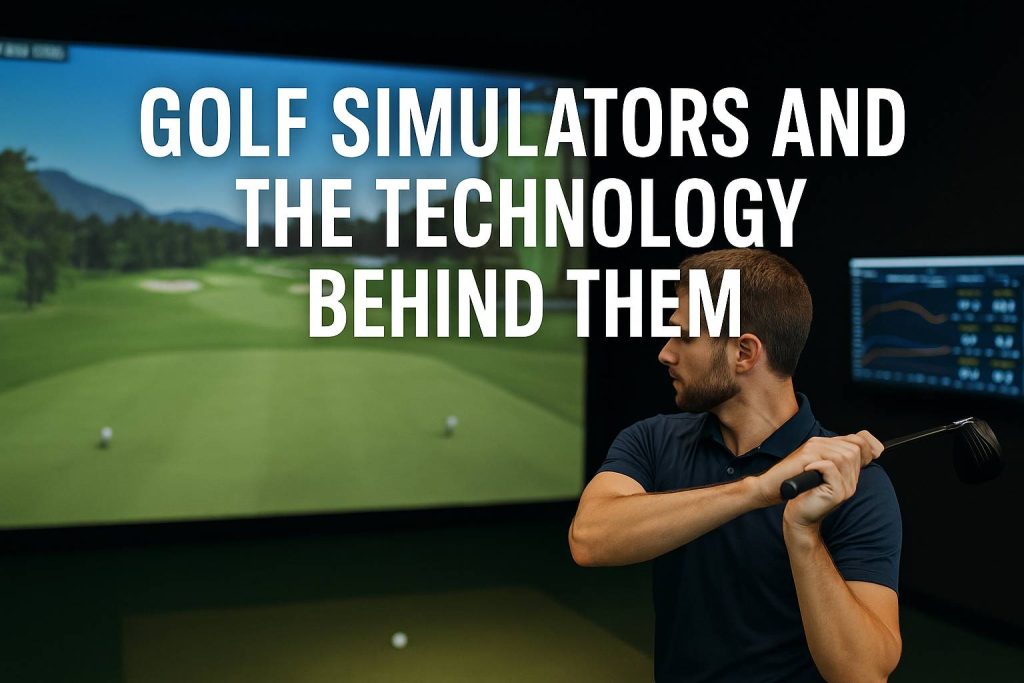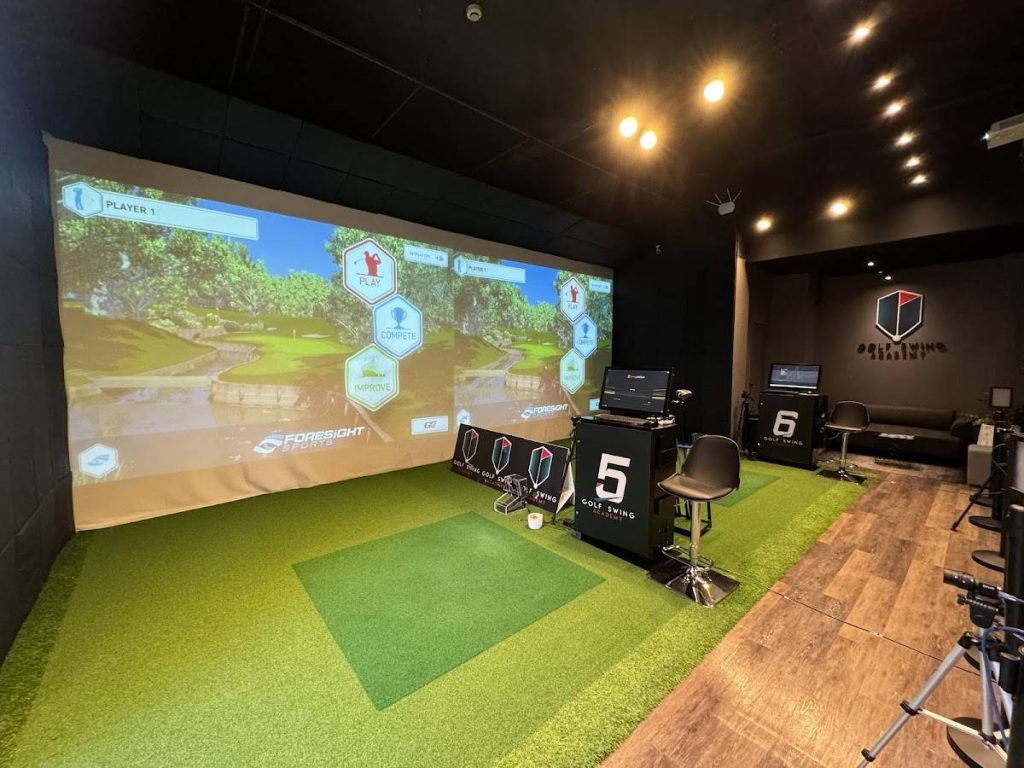A golf simulator is one of the most remarkable outcomes of modern technological advancement in the world of sports. By combining sophisticated hardware with intelligent software, this system allows anyone to practice, play, and enjoy golf without being limited by time, weather, or location.
The main appeal of golf simulators lies in their ability to deliver a realistic playing experience, highly accurate data, and unmatched flexibility. Whether used for professional training, entertainment, or business purposes, golf simulators have become a valuable investment that supports the continued growth of the game in today’s digital era.
For players looking to improve their performance or simply enjoy golf without visiting a course, a simulator provides the perfect solution—offering the true sensation of golf anytime, anywhere. Below is a complete explanation prepared by GoGolf.
What Is a Golf Simulator?

A golf simulator is a modern technological innovation that enables players to practice and play golf indoors without needing a real golf course. The system integrates advanced hardware—such as sensors, cameras, radars, and projectors—with simulation software to deliver a highly realistic virtual golfing experience.
Each swing, strike, and ball trajectory is measured with precision. The simulator captures critical data points including swing speed, launch angle, ball spin, and shot direction, which are then processed and displayed on a projection screen in real time. The result is a 3D visualization of the shot’s flight path and landing—almost identical to what would occur on an actual golf course.
Golf simulators are far more than just entertainment tools; they are professional training instruments used by renowned golfers, instructors, and academies around the world. In today’s data-driven era, simulators play a vital role in performance analysis by providing real-time feedback on every aspect of a player’s technique—such as clubhead speed, impact position, and carry distance.
These systems have also expanded beyond individual use. Golf simulators can now be found in training centers, golf lounges, hotels, offices, and cafés, offering both professional practice and casual recreation. Because they require only minimal space and operate regardless of weather conditions, they are particularly popular in countries with long winters.
Thanks to ongoing technological innovation, golf simulators have become increasingly advanced—offering stunning visual realism, precise data tracking, and enhanced interactivity. Modern simulators are now multi-functional: a training platform, entertainment medium, and even a club fitting and performance testing solution for professionals.
Make golf booking effortless. Install GoGolf now!
Key Components of a Golf Simulator
Building an indoor golf simulator requires several core components. While the type and quality may vary depending on budget and purpose, the basic principle remains the same: the system must be able to capture, process, and display accurate shot data.
Here are the essential components of a golf simulator system:
1. Hitting Mat
The mat serves as the surface from which players strike the ball. It is usually made from synthetic turf designed to replicate the texture and feedback of real grass. Premium mats feature multi-layer padding to reduce wrist and joint strain during repeated swings.
2. Impact Screen or Net
Players can choose between an impact net or a projection screen. In net-based setups, the ball stops at the net without visual display, while projection-based simulators use a high-resolution screen that shows a simulated golf course in real time.
3. Sensors and Tracking Cameras
These form the core of the simulator. Using technologies like Doppler radar, infrared lasers, or high-speed cameras, sensors measure ball speed, spin rate, launch angle, and flight direction with remarkable accuracy.
4. Simulation Software
The software processes all collected data and generates the visual ball flight simulation. Leading programs such as FSX 2020 (Foresight Sports) and TrackMan Golf are known for their precision and lifelike gameplay. Many offer access to hundreds of world-famous golf courses in digital form.
5. Projector and Audio System
A high-quality projector displays the virtual course in vivid detail, while surround audio systems enhance realism by replicating the sound of club impact, wind, and environmental effects.
Additional enhancements may include controlled lighting, powerful gaming PCs, swing analysis cameras, or even VR (Virtual Reality) integration for a fully immersive experience.
Every golfer’s setup is unique. Some opt for a simple setup with just a hitting mat, net, and laptop, while others invest in custom-built simulator rooms complete with advanced tracking and cinematic visuals. Many start with a basic kit and upgrade over time to create their dream golf studio.
How a Golf Simulator Works

A golf simulator operates by collecting shot data and converting it into visual feedback through advanced algorithms. When a player hits the ball, sensors capture the motion of both the club and ball, and the software translates that data into a virtual representation on screen.
The process generally follows four main stages:
- Detection and Data Collection: When the ball is struck, sensors instantly record parameters such as ball speed, launch angle, backspin and sidespin, and initial direction.
- Software Processing: This data is then transmitted to simulation software (e.g., FSX 2020, E6 Connect), which calculates the ball’s trajectory using complex physics models that simulate real-world aerodynamics.
- Visualization and Feedback: The shot is displayed in 3D on the projector screen, showing the full flight path and landing position. Players can immediately see whether the shot fades, slices, hooks, or lands on the fairway.
- Advanced Data Analysis: The simulator stores all shot data for further review. Golfers can study their averages, shot dispersion, and club performance to identify patterns and refine their techniques.
Tracking technologies typically fall into three categories: camera-based, radar-based, and infrared-based systems.
- Camera-based systems capture ultra-high-speed images to track motion frame by frame.
- Radar systems (Doppler-based) use electromagnetic waves to measure velocity and direction.
- Infrared systems detect ball movement via light beams interrupted by impact.
Some premium simulators combine multiple systems to achieve unparalleled accuracy. Professional devices like TrackMan and GCQuad can even record clubface rotation and impact dynamics, making them invaluable for tour players and coaches.
This high level of detail transforms modern golf simulators into powerful biomechanical tools, capable of supporting both recreational and elite-level training.
Uses and Benefits of Golf Simulators
Golf simulators deliver tremendous benefits to players, coaches, and enthusiasts alike. Their versatility has revolutionized how people learn, train, and enjoy golf around the world.
1. Effective Practice Tool
Simulators allow players to practice year-round, unaffected by weather or daylight. Rain, wind, or heat are no longer barriers. Users can adjust wind direction, course difficulty, and green speed to simulate various playing conditions.
2. Technical Analysis Device
With advanced tracking technology, players receive instant feedback on crucial metrics—club speed, ball spin, launch angle, and carry distance. This data helps identify weaknesses and guide systematic improvement.
3. Virtual Gameplay
Modern simulators feature digital recreations of world-famous golf courses such as Pebble Beach, St. Andrews, and Augusta National. Players can experience these legendary venues from the comfort of their own homes.
4. Social and Recreational Entertainment
Simulators are increasingly installed in homes, hotels, cafés, and corporate lounges, creating fun, social environments where people can play casually or compete with friends.
5. Professional Coaching and Club Fitting
In the professional golf industry, simulators are used for club fitting, equipment testing, and swing calibration. The detailed data allows coaches and manufacturers to fine-tune every element of performance.
Ultimately, a golf simulator is a long-term investment that provides both entertainment and measurable improvement — a perfect fusion of fun and function.
Types of Golf Simulators
Golf simulators come in various models and configurations depending on space, budget, and user preference.
1. Net-Based Simulators
The simplest and most affordable type, these setups feature a hitting mat and net without visual projection. Data is displayed on a monitor or mobile device — perfect for small home spaces.
2. Projected Simulators
These systems use a large projection screen to display virtual courses, creating an immersive experience ideal for realistic practice or group play.
3. Portable Simulators
Compact devices such as Rapsodo, Garmin Approach R10, or FlightScope Mevo+ are designed for portability. They can be used both indoors and outdoors, offering flexible practice options.
4. Premium or Custom-Built Simulators
These are high-end setups featuring dedicated rooms, multi-sensor tracking, cinematic projectors, and professional lighting—commonly found in golf academies, luxury homes, or resorts.
Simulators also differ based on their data tracking systems, software compatibility, and integration with mobile or VR devices, giving users full customization freedom.
Modern Applications and Lifestyle Integration
Beyond training, golf simulators have evolved into an integral part of modern leisure and lifestyle. Their versatility extends to numerous functions, including:
- Family and Social Entertainment – A fun activity for all ages, turning golf into a family-friendly game.
- Online Competitions – Many platforms now host global tournaments where players compete virtually.
- Educational Media – A great tool to introduce golf to children and beginners interactively.
- Data-Driven Coaching – Used by instructors to analyze swing mechanics and develop strategic game plans.
- Business and Tourism – Hotels, resorts, and entertainment venues use simulators to attract guests and enhance experiences.
With such wide-ranging applications, golf simulators perfectly represent the intersection of technology, sport, and modern living. From personal use at home to professional tournaments and luxury venues, this innovation continues to redefine how golf is played and enjoyed worldwide.
[ Follow our social media Account: GoGolf Instagram | GoGolf Facebook | GoGolf X ]











